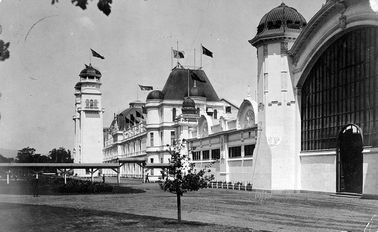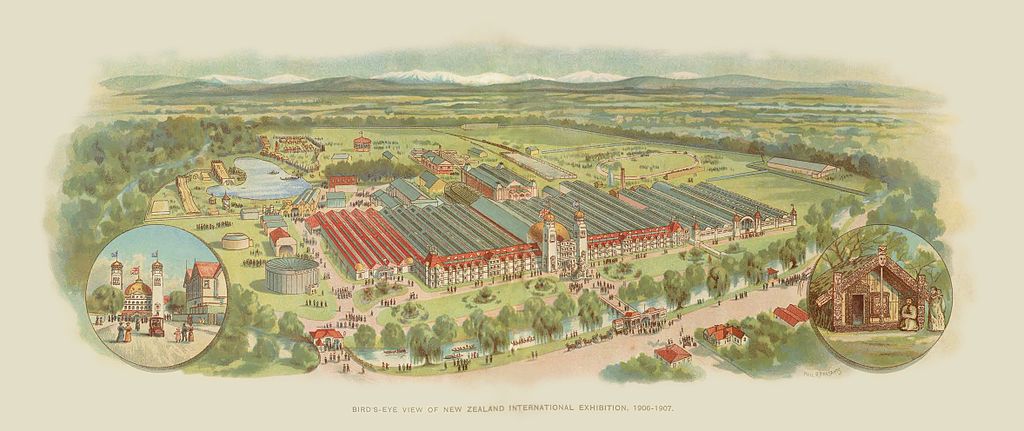Sir John Hall and the New Zealand International Exhibition 1906-1907
Hagley Park Christchurch
Sir John Hall, having been the first chairman of the Christchurch Municipal Council in 1862, was invited to be mayor for the exhibition year. He declined the request initially because of his age (he was eighty one at the time) and his unwillingness to undertake an election contest. In the end, after continuing pressure, he agreed. His only rival withdrew and Sir John's mayoralty was endorsed by both sides of the political fence. His portrait as Mayor, painted by W. A. Bowring in 1906, hangs in the Main Office at Terrace Station.
The 1906-7 International exhibition was by far the largest event held in Christchurch from 1850 to 1907 and probably since, when the size of the population at the time is taken into account. Following a long tradition of exhibitions held in England and Europe, it was, at that time, the largest exhibition to be held in the southern hemisphere. Nearly two million visitors attended. The population of the country was not yet one million. It was probably the most ambitious of all similar projects to be held and marked New Zealand's transition from colony to dominion.
Richard Seddon laid the foundation stone in December 1905 and buildings, covering more than 5 hectares, were erected in Hagley Park. The buildings were the largest structure erected in New Zealand up to that time. The size can be gauged by the fact that a temporary railway line was constructed from Riccarton across Hagley Park to bring in timber for the exhibits and buildings which were fully removed at the end of the exhibition. Sir John Hall made an entry in his diary, 8 May 1906: ‘[The buildings] are enormous ... One thing is certain, second hand timber ought to be cheap next May.’
Hagley Park Christchurch
Sir John Hall, having been the first chairman of the Christchurch Municipal Council in 1862, was invited to be mayor for the exhibition year. He declined the request initially because of his age (he was eighty one at the time) and his unwillingness to undertake an election contest. In the end, after continuing pressure, he agreed. His only rival withdrew and Sir John's mayoralty was endorsed by both sides of the political fence. His portrait as Mayor, painted by W. A. Bowring in 1906, hangs in the Main Office at Terrace Station.
The 1906-7 International exhibition was by far the largest event held in Christchurch from 1850 to 1907 and probably since, when the size of the population at the time is taken into account. Following a long tradition of exhibitions held in England and Europe, it was, at that time, the largest exhibition to be held in the southern hemisphere. Nearly two million visitors attended. The population of the country was not yet one million. It was probably the most ambitious of all similar projects to be held and marked New Zealand's transition from colony to dominion.
Richard Seddon laid the foundation stone in December 1905 and buildings, covering more than 5 hectares, were erected in Hagley Park. The buildings were the largest structure erected in New Zealand up to that time. The size can be gauged by the fact that a temporary railway line was constructed from Riccarton across Hagley Park to bring in timber for the exhibits and buildings which were fully removed at the end of the exhibition. Sir John Hall made an entry in his diary, 8 May 1906: ‘[The buildings] are enormous ... One thing is certain, second hand timber ought to be cheap next May.’
 Main Exhibition Building by J. C. Maddison
Main Exhibition Building by J. C. Maddison
A tram line was constructed to convey visitors from the Railway Station on Moorhouse Avenue via Cathedral Square to the entrance. The main entrance was from Kilmore Street where a bridge was erected across the Avon River. Victoria Lake was enlarged to accommodate two water slides and several waka, including a large ceremonial waka from Kaiapoi and several from the Whanganui River.
Visitors and exhibitors came from all over the world with significant entries from Great Britain, Canada, the United States of America and Australia. Other smaller displays came from European countries, British Empire colonies and the Far East, as well as from New Zealand. In addition to the trade and individual entries in the main buildings, there was a substantial entertainment area known as Wonderland. Here were all kinds of attractions including high speed rides down a ramp into the lake. A beautiful fernery was constructed and was a most popular exhibit. There were well laid out gardens, a restaurant, displays of bands and marching, sports and the list goes on! Each day there were special events, detailed in a news sheet and an orchestra put on performances every night. This was the first time a full orchestra, including an organ, had been seen in New Zealand.
A complete Maori Pa was constructed and occupied, and Maori were encouraged to participate in all the day to day activities.
Visitors and exhibitors came from all over the world with significant entries from Great Britain, Canada, the United States of America and Australia. Other smaller displays came from European countries, British Empire colonies and the Far East, as well as from New Zealand. In addition to the trade and individual entries in the main buildings, there was a substantial entertainment area known as Wonderland. Here were all kinds of attractions including high speed rides down a ramp into the lake. A beautiful fernery was constructed and was a most popular exhibit. There were well laid out gardens, a restaurant, displays of bands and marching, sports and the list goes on! Each day there were special events, detailed in a news sheet and an orchestra put on performances every night. This was the first time a full orchestra, including an organ, had been seen in New Zealand.
A complete Maori Pa was constructed and occupied, and Maori were encouraged to participate in all the day to day activities.
The exhibition was opened with pomp and ceremony by the Governor, Lord Plunket, on 1 November 1906 and closed on 15 April 1907.
Comment has been made that Sir John Hall held the position of mayor for the exhibition in an honorary capacity. However, once installed on 2 May 1906, he was very involved and attended frequent meetings throughout the winter months, sometimes late into the night. His home in Christchurch was in Park Terrace on the corner of Chester Street West, opposite the exhibition site. His reluctance to take on the role of mayor had, in part, been due to declining health. He often commented that maybe the position was too much for him. Unfortunately, he was not well enough to attend the official opening, though he had attended many official functions prior to then. He died in July 1907 just a few months after the closing of the exhibition. In his role as mayor, Sir John encouraged the construction of a Suffrage Display as he was keen that New Zealand's pioneering example should be recognised. He also ensured that school children from Christchurch and Hororata district would be able to visit the exhibition by paying their entrance fees.
In the main office at Terrace Station are many items from the Exhibition and these are able to be viewed by visitors.
Further history of the Exhibition
Collection of Images from the Exhibition
Return to main page
Comment has been made that Sir John Hall held the position of mayor for the exhibition in an honorary capacity. However, once installed on 2 May 1906, he was very involved and attended frequent meetings throughout the winter months, sometimes late into the night. His home in Christchurch was in Park Terrace on the corner of Chester Street West, opposite the exhibition site. His reluctance to take on the role of mayor had, in part, been due to declining health. He often commented that maybe the position was too much for him. Unfortunately, he was not well enough to attend the official opening, though he had attended many official functions prior to then. He died in July 1907 just a few months after the closing of the exhibition. In his role as mayor, Sir John encouraged the construction of a Suffrage Display as he was keen that New Zealand's pioneering example should be recognised. He also ensured that school children from Christchurch and Hororata district would be able to visit the exhibition by paying their entrance fees.
In the main office at Terrace Station are many items from the Exhibition and these are able to be viewed by visitors.
Further history of the Exhibition
Collection of Images from the Exhibition
Return to main page


